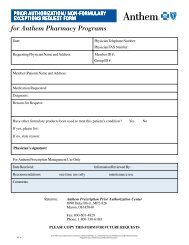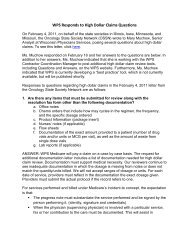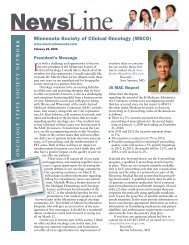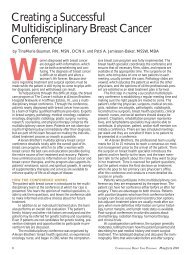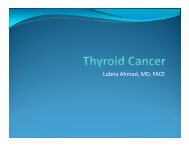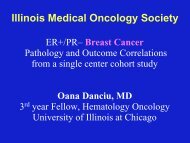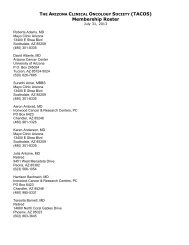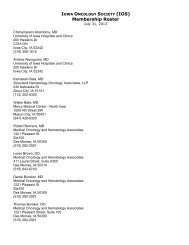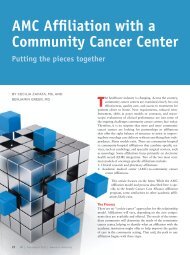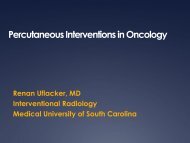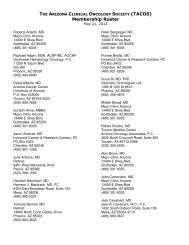Cancer Program Guidelines - Association of Community Cancer ...
Cancer Program Guidelines - Association of Community Cancer ...
Cancer Program Guidelines - Association of Community Cancer ...
Create successful ePaper yourself
Turn your PDF publications into a flip-book with our unique Google optimized e-Paper software.
Characteristics<br />
A. Rehabilitation includes, but is not limited to:<br />
1. Patient and family<br />
2. Attending physicians<br />
3. Oncology nursing services (See Chapter 4, Section<br />
4, Oncology Nursing Services.)<br />
4. Psychosocial services (See Chapter 4, Section 6,<br />
Psychosocial Oncology Care.)<br />
5. Nutritional support services (See Chapter 4,<br />
Section 8, Nutrition Services.)<br />
6. Pharmacy services (See Chapter 4, Section 5,<br />
Pharmacy Services.)<br />
7. Pastoral care services (See Chapter 4, Section<br />
14, Pastoral Care.)<br />
8. Physical, occupational, and recreational therapy<br />
services<br />
9. Speech pathology services<br />
10. Comprehensive, multidisciplinary lymphedema<br />
services<br />
11. Enterostomal therapy services<br />
12. Discharge planning services to address home<br />
care, community, and/or extended care facility<br />
services and needs<br />
13. Qualified volunteer services to provide support<br />
and advocacy for cancer patients and their<br />
families<br />
14. Other complementary services, such as music/<br />
art therapy, relaxation, massage, and others<br />
may be used in conjunction with rehabilitation<br />
disciplines.<br />
B. Each healthcare discipline is available on staff or by<br />
consult to facilitate continuity <strong>of</strong> care for rehabilitation<br />
services. All outsourced services should be provided by<br />
properly credentialed individuals whose performance is<br />
reviewed annually.<br />
C. Mechanisms exist, when necessary, to review the rehabilitation<br />
plan and coordinate communication among the<br />
various members <strong>of</strong> the rehabilitation team.<br />
D. Rehabilitation services are a part <strong>of</strong> the organizational<br />
structure <strong>of</strong> the program, follow proper policies and<br />
procedures, and are available to cancer patients and their<br />
families throughout their continuum <strong>of</strong> care.<br />
E. Ongoing educational opportunities are available to<br />
members <strong>of</strong> rehabilitation services.<br />
F. A mechanism is in place to inform patients and family<br />
members <strong>of</strong> the services available.<br />
Section 10<br />
Patient Navigation Services<br />
Guideline I<br />
A patient navigation program is available for patients,<br />
their families, and caregivers to help “overcome health<br />
care system barriers and facilitate timely access to<br />
quality medical and psychosocial care from pre-diagnosis<br />
through all phases <strong>of</strong> the cancer experience.” *<br />
Rationale<br />
The diagnosis and treatment <strong>of</strong> cancer and living with the<br />
disease may be confusing, intimidating, and overwhelming<br />
for an individual, family member, or caregiver. <strong>Cancer</strong><br />
programs have a responsibility to assist our patients, their<br />
families, and caregivers to navigate the continuum <strong>of</strong> care<br />
through a navigation program developed by the cancer program<br />
or via a partnership with a community agency that<br />
utilizes patient navigators. Since each cancer program understands<br />
its unique patient population and its community, individual<br />
programs or health systems can best create a navigator<br />
system that suits its needs.<br />
Characteristics<br />
A. Patient navigation may include but is not limited to<br />
oncology social worker(s) and nurse(s) who may:<br />
1. Act as a coordinator to ensure the patient, their<br />
family members, and caregivers move through<br />
the complexities <strong>of</strong> the system in a timely fashion<br />
2. Provide psychosocial services to patients, families,<br />
and caregivers or refer to oncology social<br />
worker for psychosocial care<br />
3. Link patients, families, and caregivers with<br />
appropriate community resources (i.e., financial,<br />
transportation, translation services, and hospice)<br />
4. Provide education to the patient, families, and<br />
caregivers throughout the continuum <strong>of</strong> care<br />
*From a definition created by C-Change, May 20, 2005. Permission<br />
granted. “Patient navigation in cancer care refers to individualized<br />
assistance <strong>of</strong>fered to patients, families, and caregivers to help<br />
overcome health care system barriers and facilitate timely access to<br />
quality medical and psychosocial care from pre-diagnosis through<br />
all phases <strong>of</strong> the cancer experience.”<br />
20 Chapter 4 Clinical Management and Supportive Care Services ACCC <strong>Cancer</strong> <strong>Program</strong> <strong>Guidelines</strong>



